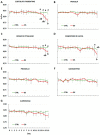Drought Stress Affects the Response of Italian Local Tomato (Solanum lycopersicum L.) Varieties in a Genotype-Dependent Manner
- PMID: 31500309
- PMCID: PMC6783988
- DOI: 10.3390/plants8090336
Drought Stress Affects the Response of Italian Local Tomato (Solanum lycopersicum L.) Varieties in a Genotype-Dependent Manner
Abstract
Drought stress is one of the most severe conditions for plants, especially in the face of the emerging problem of global warming. This issue is important when considering economically relevant crops, including the tomato. For these plants, a promising solution is the valorization of local agrobiodiversity as a source of genetic variability. In this paper we investigated how six Italian tomato varieties react to a prolonged period of water depletion. We used a multidisciplinary approach, from genetics to plant physiology and cytology, to provide a detailed overview of the response of plants to stress. The varieties analyzed, each characterized by a specific genetic profile, showed a genotype-specific response with the variety 'Fragola' being the most resistant and the variety 'Pisanello' the most susceptible. For all the parameters evaluated, 'Fragola' performed in a manner comparable to that of control plants. On the contrary, 'Pisanello' appeared to be more affected and showed an increase in the number of stomata and a drastic increase in antioxidants, a symptom of acute oxidative stress. Our work suggests the existence of a valuable reservoir of genetic biodiversity with more drought-tolerant tomato genotypes opening the way to further exploitation and use of local germplasm in breeding programs.
Keywords: Italian varieties; drought stress; oxidative stress; physiological response; tomato.
Conflict of interest statement
The authors declare no conflict of interest.
Figures











References
-
- Dai A. Increasing drought under global warming in observations and models. Nat. Clim. Chang. 2013;3:52–58. doi: 10.1038/nclimate1633. - DOI
-
- Farooq M., Wahid A., Kobayashi N., Fujita D., Basra S.M.A. Sustainable Agriculture. Springer; Dordrecht, The Netherlands: 2009. Plant Drought Stress: Effects, Mechanisms and Management; pp. 153–188.
-
- Pirasteh-Anosheh H., Saed-Moucheshi A., Pakniyat H., Pessarakli M. Water Stress and Crop Plants. Wiley; Hoboken, NJ, USA: 2016. Stomatal responses to drought stress; pp. 24–40.
LinkOut - more resources
Full Text Sources

